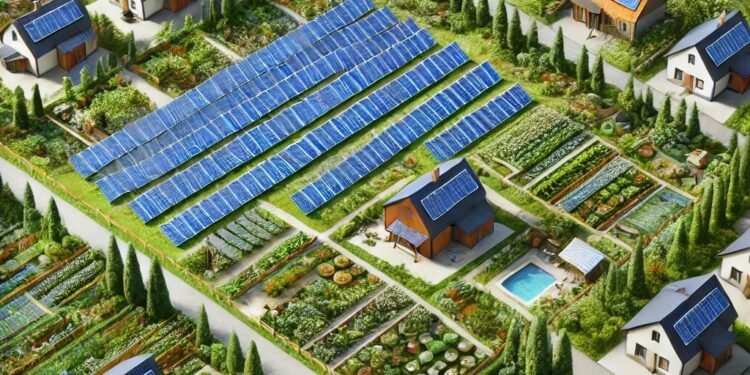Community solar gardens are a revolutionary concept in the renewable energy space, allowing multiple individuals, businesses, or organizations to share the benefits of a centralized solar energy system. Unlike traditional solar systems installed on individual rooftops, community solar gardens serve a group of subscribers, providing access to clean energy even for those who cannot install solar panels at their own properties.
What Is a Community Solar Garden?
A community solar garden, also known as a solar farm or shared solar, is a solar power plant whose electricity is shared by more than one household or business. The garden is typically located on a large plot of land, away from the properties it serves, but the power generated from the solar panels is distributed to participating subscribers via the local utility grid.
Subscribers can be homeowners, renters, small businesses, or even nonprofits that either buy or lease a portion of the solar energy produced by the garden. In return, they receive credits on their electricity bills based on the amount of power generated by their share of the system.
How Community Solar Gardens Work: Step-by-Step
1. Site Selection and Construction: A developer identifies a suitable location for the solar garden—typically a large, open area with plenty of sunlight. The solar panels are then installed in this location, along with the necessary infrastructure to connect the garden to the local utility grid.
2. Subscriptions: Community members, including individuals, businesses, or organizations, subscribe to a portion of the solar garden. Subscriptions can be structured in different ways. Some subscribers may buy a set number of panels or a share of the system, while others may lease their portion for a fixed term.
3. Energy Generation and Distribution: Once the solar garden is operational, it begins generating electricity. This power is fed into the local utility grid, where it becomes part of the overall electricity supply. Subscribers don’t receive electricity directly from the solar garden to their homes; instead, their utility monitors the amount of electricity generated by their portion of the solar garden.
4. Bill Credits: Subscribers receive credits on their utility bills for the amount of electricity their share of the garden produces. The more sunlight the garden receives, the more energy it generates, leading to higher savings for subscribers. These bill credits can help offset or even eliminate their electricity costs, depending on the size of their subscription.
5. Maintenance and Operations: The solar garden is typically managed by a third-party developer or a utility, which handles all maintenance, repairs, and operations. This is one of the key benefits of community solar—subscribers can enjoy the financial and environmental benefits of solar power without the hassle of installation or upkeep.
Advantages of Community Solar Gardens
Community solar gardens offer several advantages over traditional rooftop solar installations:
1. Accessibility: One of the main benefits of community solar is that it makes solar energy accessible to more people. Renters, those with shaded roofs, or individuals living in apartments or condominiums can participate in solar energy production, even if they can’t install solar panels at home.
2. Cost Savings: By participating in a community solar garden, subscribers can save money on their electricity bills. Depending on the arrangement, subscribers may pay less for their solar-generated electricity than they would for traditional grid electricity, resulting in significant long-term savings.
3. Environmental Impact: Like all solar power, community solar gardens contribute to reducing greenhouse gas emissions and reliance on fossil fuels. By participating, subscribers can directly contribute to cleaner energy in their region.
4. No Upfront Costs: Many community solar programs allow subscribers to participate without any upfront investment. Instead of purchasing panels, they may pay a monthly fee or enter into a lease agreement, making solar energy more affordable.
5. Flexibility: Community solar is ideal for people who may move frequently, such as renters. Because the solar garden is off-site, subscribers can retain their subscription when they move, as long as they remain within the utility service area.
Challenges and Limitations
While community solar gardens offer numerous benefits, they are not without challenges:
• Availability: Community solar gardens are not yet available in all regions. Availability depends on state regulations, local policies, and utility company offerings. Some states and countries are more advanced in promoting community solar than others.
• Subscription Models: Some subscription models may not provide immediate savings, as participants may need to pay upfront or ongoing fees. It’s important to understand the financial terms of any community solar agreement before signing up.
• Capacity Limits: Community solar gardens have limited capacity, and not everyone who wants to participate may be able to. Demand for subscriptions can sometimes outstrip supply.
The Future of Community Solar
As the global push for renewable energy intensifies, community solar gardens are expected to play a key role in expanding access to clean energy. Many governments and utilities are developing programs to incentivize community solar, recognizing its potential to democratize access to renewable energy and accelerate the transition away from fossil fuels.
In the future, advances in solar technology, energy storage, and smart grid infrastructure may further enhance the benefits of community solar. With greater awareness and support, community solar gardens could become a cornerstone of sustainable energy solutions worldwide, enabling more people to participate in the clean energy revolution, regardless of where they live.
Community solar is proving that solar power isn’t just for the wealthy or those with ideal rooftops—it’s a solution for everyone, fostering greater equity in the transition to a low-carbon future.










































